The reel doesn't really need a disc drag, because you cannot be so playful
as to let the fish run. After giving a solid strike, you must coax dorado's
charge with force. Pay out as little line, and pull up the fish quick using
rod's leverage. (important not only for you to catch him but for dorado
released safely, in the hostile environment with lots of hungry teeth around.)
Though only a juvenile fish around 40cm, the sense of relief my first dorado
gave me was indeed enormous. On the twilight river just turning into golden,
I shook hands firm with Senor y Senorita.
With a piece of relief and still a mountain of anxiety, our Day 1 thus
ended.
Palometa as our sparring partner, we kept training ourselves And as I ran into the 5th or 6th round, the golden explosion happened to me once again.
''Con mano! Mas fuerte!! Bien, otra vez!''
(With the hand! Harder!! Yes, once again!).
Rallied by Marcelo's shouts from behind, I stroke with my left hand as
hard as could.
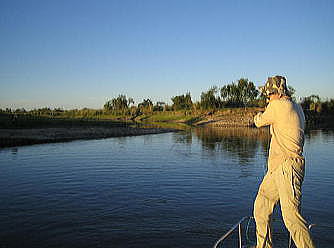
Sayuri, true to the image training, jerked the rod with all her might.
The dorado shot itself in the air once, and twice, before managing to throw
the hook off. Picking up Sayuri's rod, our guide, Senor Marcelo frowned.
''Not strong enough. You need a much stiffer one''. Well, maybe so, but
even this rod has a casting weight of 1Oz. If this one's not tough enough,
how much chance is there with those softy fly rods!?
After a while of restless anticipation, I too received a strike of dorado
at last. But just as I feared, the fish threw off the hook on the first
jump. ''No no, you never hook up a dorado pulling a rod'' Marcelo gave
us a demonstration ''Leave the rod pointing at the fish. And, see my left
hand? THERE!! Pull the flyline real hard. That's how you nail a Dorado.
Entiendes?'' . . Si, entiendo. At least in theory.
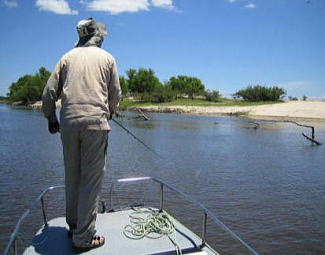
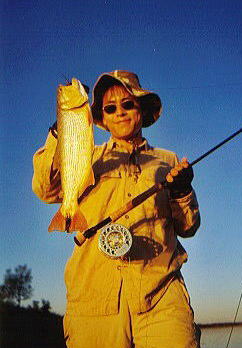
The first action fell on Sayuri's rod, within minutes of working a Rapala
CD14. Her casting reel with strong drag was paying out the line. God, could
this be . . !?
Nope, catching a dorado cannot be so easy! The fish she pulled up was a
toothy devil - a big piranha, called Palometa locally. Not a happiest looking
amigo, but made a quite nice kick-off ceremony nonetheless.
Allas, what followed was a parade of big toothy Palometas one after another. All weighing 3 to 4lbs, they were good playmates. As we anxiously wondered on, yet another shock hit Sayuri. Before she could say a thing, the water in front exploded in a golden fury - There, DORAAADOO!!
Water was still low as we visited in November, and at some locations our
boat got washed up on submerged sand bars, where we had to wade and pull
her off. At other places river was fairly deep. Occasional big holes where
the currents were making whirlpools or carving rocks out of crumbling cliffs.
Under this circumstance dorados wait in covers for unwary preys. The key
to success therefore is pin-point casting, hitting that shadow underneath
the bush, probing this pocket behind the rock, or check that small riffle
by the sunken log.
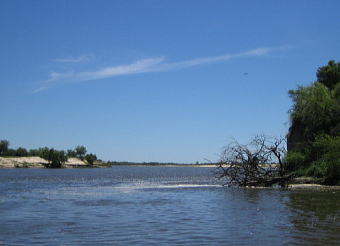
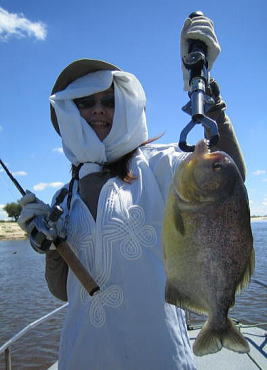
Rio Corrientes mouths into the great Parana, near the historic town of
Esquina. The fishing lodge, Estancia La Pelada, is an hour's dirt ride
from there to the north.
The river at this lower stretch is quite wide, spreading up to 300meters
across. The water here is off-colored due to the fine mud sediments, limiting
the visibility down to, say, 10inches or perhaps less.
Not a familiar environment for us trout fishermen, but the abundance of
fishy looking spots was enough to rush us threading the line.




